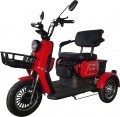Max. load
The maximum additional weight that a vehicle is designed to carry is, in fact, the weight of the payload that it is allowed to carry.
The maximum load includes both the passenger himself and the things he carries. In this case, the value is usually indicated based on a flat road and a quiet ride. So, ideally, it is best to have a maximum weight margin of at least 10-15 kg — this will give an additional guarantee in case of emergencies, such as a wheel falling into a pothole.
Range
The range of a vehicle is the distance it can travel on a single battery charge.
Note that the range usually indicates the value for perfect operating conditions: driving at optimal speed with a small load, flat road, no ups and downs, etc. The actual range may differ from the claimed one, sometimes quite noticeably. In addition, to improve range, manufacturers can deliberately use low-power motors that consume little energy.
Max speed
The highest speed that a vehicle can reach.
When choosing according to this parameter, it is worth considering that in dense city traffic, it is rarely possible to accelerate faster than 40 km/h; so if the vehicle is bought mainly for a comfortable ride through traffic jams, then there is no need to look for a high-speed model. In addition, for the same motor power, low speed means more torque, which makes it easier to climb hills.
Wheel size
tThe diameter of the wheels used in the vehicle. For models with wheels of different sizes, the largest diameter is usually indicated, other data can be specified in the notes.
For electric scooterbikes, the traditional size is a modest 10"; larger sizes are also found — up to
16". Among minibikes, large
18" wheels are more common. Electric motorcycles have small wheels — an average of 12 – 14". Among electric tricycles, a combination of a large front wheel with small rear wheels is often found — for example, 16 "and 4" each, respectively.
The large diameter allows you to roll over the bumps on the road, overcome rather large obstacles and maintain speed longer when coasting; on the other hand, such wheels require more torque from the engine, they accelerate worse and reduce the maximum speed of the unit. Small wheels, on the contrary, accelerate well and also provide good manoeuvrability, but they are intended mainly for flat roads.
Power
The motor power of a vehicle, in kilowatts. In addition to them, horsepower is also used (for more details, see above).
Let us clarify that in this case, we are talking about
maximum power; the actual power can be adjusted while driving with the help of the accelerator. And in some models, it may even be possible to set a limit on the maximum power.
A more powerful motor allows you to carry more weight, reach higher speeds and/or have more torque. However, the energy consumption from the battery will also be high, and the battery life, with the same battery capacity, will be correspondingly less than when using a less powerful motor. Also note that in many countries, motor power is a criterion for classifying an electric vehicle as one or another variety. For example, according to this criterion, motorcycles and scooters can be formally separated, requiring different driving licences.
Battery capacity
The capacity of the battery installed in the vehicle, in ampere-hours.
Theoretically, the battery life of the vehicle directly depends on this parameter: a more capacious battery can supply the electric motor longer. However, the actual amount of stored energy depends not only on the capacity in amp-hours but also on the nominal voltage of the battery. A more correct unit in this sense is watt-hours, taking into account the difference in nominal voltages; see "Battery capacity" below for details on this designation. Additionally, the operating time on a charge will depend not only on the characteristics of the battery but also on the power consumption of the vehicle itself — and it is determined by the motor power and several other parameters.
Weight
The total weight of the vehicle without cargo and rider.
The
lighter the unit, the greater the range and, accordingly, the weight of the payload that can be carried on it. On the other hand, too little weight adversely affects the stability, and sometimes the overall strength of the structure.

